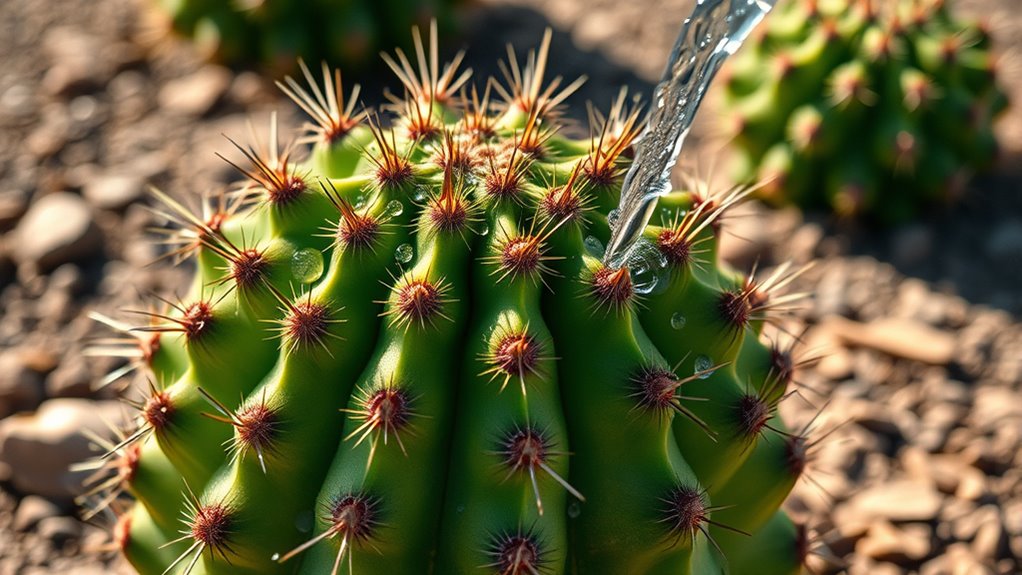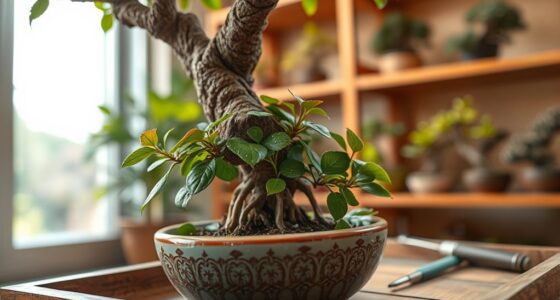Many common cactus care myths can harm your plant if followed blindly. Frequent watering isn’t necessary—cacti thrive on infrequent, deep soaking, especially during active growing seasons. Overwatering causes root rot and weakens plants, so wait until the soil is completely dry. Good drainage and seasonal adjustments are essential for healthy growth. To become a cactus care expert, discover more about proper watering practices and bust these myths for a thriving plant.
Key Takeaways
- Overwatering harms cacti; water only when soil is completely dry, typically every few weeks.
- Seasonal adjustments are essential; water more during active growth and less during dormancy.
- Proper soil drainage prevents root rot and mimics natural desert conditions.
- Myth: watering once or twice a year is enough; regular, cautious watering promotes healthier growth.
- Consistent, sparing watering combined with good drainage supports resilient, thriving cacti.

Many common beliefs about caring for cacti are actually myths that can hinder their health and growth. One of the biggest misconceptions is that cacti need frequent watering. You might think that watering your cactus regularly will keep it healthy, but in reality, overwatering is one of the quickest ways to harm it. Cacti are desert plants adapted to survive with minimal water, so their watering frequency should be infrequent. Typically, you only need to water your cactus when the soil is completely dry, which might be every few weeks or even longer, depending on your environment. This prevents the roots from rotting and encourages the plant to develop a strong, resilient root system. Remember, the key is to allow the soil to dry out thoroughly between watering sessions. Additionally, understanding soil drainage is essential; improper drainage can lead to root rot and other issues. Many newcomers also believe that watering once or twice a year is enough for cacti. While cacti are drought-tolerant, they still need some water during their active growing season—usually spring and summer. During these times, you might water every few weeks, but in winter, when the plant enters dormancy, watering should be reduced further. Ignoring this seasonal variation can lead to stress or poor growth. Also, don’t assume that a cactus will bounce back quickly from neglect; consistent but sparing watering combined with good soil drainage will promote healthier, happier plants.
Frequently Asked Questions
Do Cacti Require Frequent Watering During Winter Dormancy?
You might wonder if cacti need winter watering during dormancy. In reality, you should limit winter watering to prevent overhydration, as cacti enter dormancy and need less water. Focus on dormancy hydration by watering sparingly, only when the soil is completely dry. This approach helps prevent root rot and keeps your cactus healthy through colder months. Remember, less is more during cactus dormancy!
Can Cacti Thrive Indoors Without Direct Sunlight?
You might think cacti can thrive indoors without direct sunlight, but that’s like putting all your eggs in one basket. While they can survive in lower light, they truly flourish with ample indoor lighting or sunlight alternatives like grow lights. To keep your cactus happy, place it near a south-facing window or use artificial lights if natural sunlight isn’t enough. Remember, a little extra effort pays off in a healthy, vibrant plant.
What Is the Best Soil Type for Different Cactus Species?
You should choose a well-draining soil type for different cactus species to prevent root rot. A cactus potting mix typically contains sand, perlite, or pumice to improve soil drainage. For desert cacti, opt for a sandy, gritty mix, while for tropical species, add organic matter for moisture retention. Always guarantee the soil allows excess water to drain quickly, keeping your cacti healthy and thriving.
How Often Should I Repot My Cactus to Prevent Root Rot?
Don’t put all your eggs in one basket when it comes to repotting your cactus. You should repot every 2-3 years or when it outgrows its current container, whichever comes first. Adjust your watering frequency accordingly, as overwatering can lead to root rot. Regular repotting refreshes the soil, prevents root damage, and keeps your cactus healthy. Keep a close eye, and you’ll keep root rot at bay.
Are All Cacti Safe for Pets and Children?
Not all cacti are safe for pets and children. You should check which cacti are labeled as non-toxic, as some, like the prickly pear, are generally pet-safe, while others, such as certain toxic cacti, can cause illness if ingested. Always prioritize pet safety by keeping potentially toxic cacti out of reach, and educate yourself on which species are safe. When unsure, consult with a vet or expert on toxic cacti.
Conclusion
Now that you’ve uncovered the truth behind common cactus care myths, you’re ready to give your plant the best. But don’t get too comfortable—there’s always more to learn about keeping your cactus thriving. A simple mistake could still surprise you, or perhaps reveal an unexpected secret to its health. Are you prepared to take your cactus care to the next level? Stay curious—your green thumb might just be about to surprise you.









